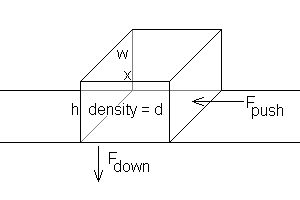Coefficient of Friction
Steven Dutch, Professor Emeritus, Natural and Applied Sciences,University of Wisconsin - Green BayPushing a Thrust Sheet

The downward force Fd = g * mass, where g is the gravitational acceleration. Mass is volume times density, so we have Fd = gxwhd.
In order to push the block, we have to apply force, and the heavier the block, the greater the force. The ratio Fp/fd is called the coefficeient of friction. Therefore, Fp = fFd = fgxwhd.
The stress, s, we apply to the end of the block to push it is simply s = Fp/area = fgxwhd/wh = fgxd. We note that w disappears. That doesn't surprise us, since we could imagine scaling the model arbitrarily in the width direction and having all quantities scale proportionately. That h also disappears is much more surprising; we'd expect the stress to depend somehow on the thickness of the block. It actually makes sense that h disappears. If we make the block thicker, Fd and Fp do increase, but so does the cross-sectional area of the block, so that s remains constant.
g is 9.8 meters per second squared and d can be taken as 2600 kg per cubic meter. If f = 0.5, a reasonable value for bare rock, and x = 1 km (1000 meters) then s = 12.7 Mpa (127 bars). That is, it takes 127 bars of stress to push a 1-km block of rock. Rocks begin to fracture at a few kilobars stress at low confining pressures (shallow depths). If we assume the rock fails at 200 Mpa (2 kbars), then s has to be less than 200 Mpa. Thus the length of the block can be at most x = s/fgd = 15.7 km. But there are many thrust sheets that are known to be larger than that.
Some thrust sheets are over 100 kilometers long. If the rock fails at 200 Mpa, and the length is 100 km, the only variable we can easily change is f. We have f = s/gld = .08. This is a very low coefficient of friction, comparable to lubricated steel on steel or waxed skis on snow. Most mechanical solutions of this problem rely on a combination of gravity assistance, fluid pressure for support and lubrication, and piecemeal motion, like adjusting a mattress.
Return to Course Syllabus
Return to Techniques Manual Index
Return to Professor Dutch's Home Page
Created 23 February 1999, Last Updated 12 June 2020